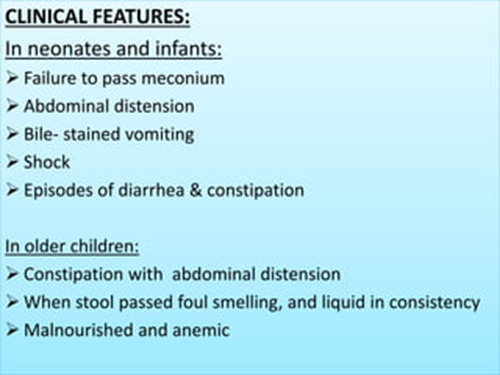A nurse is caring for a child who has Hirschsprung disease. Which of the following findings should the nurse expect?
Ridged abdomen
Ribbonlike, foul-smelling stools
Projectile vomiting
Chronic hunger
The Correct Answer is B
A. Ridged abdomen - This finding is not typically associated with Hirschsprung disease. Instead, the abdomen may appear distended or bloated due to the accumulation of stool in the colon.
B. Ribbonlike, foul-smelling stools - This is a characteristic finding in Hirschsprung disease. Because the affected portion of the colon lacks nerve cells (ganglion cells) responsible for peristalsis, stool movement is impaired, leading to the passage of narrow, ribbonlike stools. These stools may also have a foul odor due to bacterial overgrowth in the affected area.
C. Projectile vomiting - Projectile vomiting is not a common finding in Hirschsprung disease. It is more commonly associated with conditions such as pyloric stenosis or gastroesophageal reflux.
D. Chronic hunger - Chronic hunger is not a typical finding in Hirschsprung disease. Instead, affected infants may experience feeding difficulties, constipation, and failure to thrive due to the obstruction of stool in the colon. They may also exhibit symptoms such as abdominal distention, vomiting, and refusal to feed.

Nursing Test Bank
Naxlex Comprehensive Predictor Exams
Related Questions
Correct Answer is ["B","D","E"]
Explanation
A. Bed in highest position:
The height of the bed is not directly related to seizure precautions.
B. Remove restrictive objects or clothing from patients’ body:
This is important to prevent injury during a seizure episode.
C. Remove all pillows from the patient's head:
While it's generally a good practice to remove pillows to prevent suffocation or obstruction, it's not specifically related to seizure precautions.
D. Oxygen and suction at bedside:
Oxygen and suction should be readily available to support the patient's respiratory status and clear any secretions or vomit during or after a seizure.
E. Padded bed rails:
Padded bed rails can help prevent injury if the patient thrashes or moves violently during a seizure.
Correct Answer is B
Explanation
A. "I know this can be embarrassing. I have kids myself so I understand, and it doesn't bother me."
This response acknowledges the child's feelings and reassures the parents that bedwetting is a common occurrence, especially during hospitalization. It also demonstrates empathy by sharing a personal experience. However, it may not address the parents' concerns about their child's bedwetting or provide information on how to manage it.
B. "Children who are hospitalized often regress. The toileting skills will return when your child is feeling better."
This response provides an explanation for the bedwetting incident, reassuring the parents that it is a common response to hospitalization and will likely resolve once the child feels better. It offers support and normalization of the behavior, which can help alleviate the parents' concerns.
C. "I will discuss your child's loss of bladder control with the provider."
This response indicates that the nurse will address the issue with the healthcare provider, which is appropriate if further evaluation or intervention is needed. However, it may not directly address the parents' concerns or provide immediate reassurance.
D. "Why is she wetting the bed in the hospital? She must wet the bed at home."
This response may come across as accusatory or judgmental, which can increase parental anxiety or guilt. It does not provide reassurance or support to the parents and does not address the child's immediate needs.
Whether you are a student looking to ace your exams or a practicing nurse seeking to enhance your expertise , our nursing education contents will empower you with the confidence and competence to make a difference in the lives of patients and become a respected leader in the healthcare field.
Visit Naxlex, invest in your future and unlock endless possibilities with our unparalleled nursing education contents today
Report Wrong Answer on the Current Question
Do you disagree with the answer? If yes, what is your expected answer? Explain.
Kindly be descriptive with the issue you are facing.
